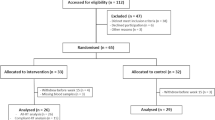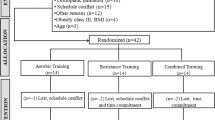Abstract
African Americans (AA) have an earlier onset of hypertension and a different vascular profile than their Caucasian (Cau) peers. Research suggests that biological mediators of vascular inflammation are different among these groups in hypertensive populations. Resistance training (RT) is an important exercise modality that improves the vascular profile of young AA men. We examined the role of RT on biomarkers of vascular function and oxidative stress in body mass index-matched AA and Cau men. RT for 6 weeks elicited significant changes in circulating matrix metalloprotease-9 (MMP-9) and 8-Isoprostane (8-IsoP) in young AA men (n=14, AA; n=18, Cau; 18–35 years). MMP-9 was lower and decreased in AA (pre: P=0.02; post: P<0.001) and a time × group interaction for MMP-9 (F1, 30=4.81; P=0.036) and 8-IsoP (F1, 24=7.09; P=0.014) was detected. 8-IsoP decreased in AA (P=0.026) but did not change in Cau (P=0.309). Notably, the increase in strength (1-repetition maximum (1-RM)) was correlated with the decrease in MMP-9 (r=−0.398; P=0.022). Furthermore, these adaptations were independent of any improvement in cardiorespiratory fitness. We demonstrate that RT effectively reduces matrix remodeling proteins and oxidative stress in young AA men. Increasing strength may be beneficial for improving vascular health and offsetting novel cardiovascular risk factors of hypertension in young AA men.
This is a preview of subscription content, access via your institution
Access options
Subscribe to this journal
Receive 12 digital issues and online access to articles
$119.00 per year
only $9.92 per issue
Buy this article
- Purchase on Springer Link
- Instant access to full article PDF
Prices may be subject to local taxes which are calculated during checkout
Similar content being viewed by others
References
Kurian AK, Cardarelli KM . Racial and ethnic differences in cardiovascular disease risk factors: a systematic review. Ethn Dis 2007; 17 (1): 143–152.
Baruth M, Wilcox S, Egan BM, Dowda M, Laken M, Warren TY . Cardiovascular disease risk factor clustering among African American adults. Ethn Dis 2011; 21 (2): 129–134.
Stein CM, Lang CC, Singh I, He HB, Wood AJ . Increased vascular adrenergic vasoconstriction and decreased vasodilation in blacks. Additive mechanisms leading to enhanced vascular reactivity. Hypertension 2000; 36 (6): 945–951.
Din-Dzietham R, Liu Y, Bielo MV, Shamsa F . High blood pressure trends in children and adolescents in national surveys, 1963 to 2002. Circulation 2007; 116 (13): 1488–1496.
Modena MG, Bonetti L, Coppi F, Bursi F, Rossi R . Prognostic role of reversible endothelial dysfunction in hypertensive postmenopausal women. J Am Coll Cardiol 2002; 40 (3): 505–510.
Guerin AP, Blacher J, Pannier B, Marchais SJ, Safar ME, London GM . Impact of aortic stiffness attenuation on survival of patients in end-stage renal failure. Circulation 2001; 103 (7): 987–992.
Reddigan JI, Ardern CI, Riddell MC, Kuk JL . Relation of physical activity to cardiovascular disease mortality and the influence of cardiometabolic risk factors. Am J Cardiol 2011; 108 (10): 1426–1431.
Collier SR, Kanaley JA, Carhart R, Frechette V, Tobin MM, Hall AK et al. Effect of 4 weeks of aerobic or resistance exercise training on arterial stiffness, blood flow and blood pressure in pre- and stage-1 hypertensives. J Hum Hypertens 2008; 22 (10): 678–686.
Okamoto T, Masuhara M, Ikuta K . Effect of low-intensity resistance training on arterial function. Eur J Appl Physiol 2011; 111 (5): 743–748.
Heffernan KS, Jae SY, Fernhall B . Racial differences in arterial stiffness after exercise in young men. Am J Hypertens 2007; 20 (8): 840–845.
Heffernan KS, Fahs CA, Iwamoto GA, Jae SY, Wilund KR, Woods JA et al. Resistance exercise training reduces central blood pressure and improves microvascular function in African American and white men. Atherosclerosis 2009; 207 (1): 220–226.
Heffernan KS, Jae SY, Vieira VJ, Iwamoto GA, Wilund KR, Woods JA et al. C-reactive protein and cardiac vagal activity following resistance exercise training in young African-American and white men. Am J Physiol Regul Integr Comp Physiol 2009; 296 (4): R1098–R1105.
Fahs CA, Heffernan KS, Ranadive S, Jae SY, Fernhall B . Muscular strength is inversely associated with aortic stiffness in young men. Med Sci Sports Exerc 2010; 42 (9): 1619–1624.
Coutinho T, Turner ST, Mosley TH, Kullo IJ . Biomarkers associated with pulse pressure in African-Americans and non-Hispanic whites. Am J Hypertens 2012; 25 (2): 145–151.
Friese RS, Rao F, Khandrika S, Thomas B, Ziegler MG, Schmid-Schonbein GW et al. Matrix metalloproteinases: discrete elevations in essential hypertension and hypertensive end-stage renal disease. Clin Exp Hypertens 2009; 31 (7): 521–533.
Yasmin, McEniery CM, Wallace S, Dakham Z, Pulsalkar P, Maki-Petaja K et al. Matrix metalloproteinase-9 (MMP-9), MMP-2, and serum elastase activity are associated with systolic hypertension and arterial stiffness. Arterioscler Thromb Vasc Biol 2005; 25 (2): 372.
Flamant M, Placier S, Dubroca C, Esposito B, Lopes I, Chatziantoniou C et al. Role of matrix metalloproteinases in early hypertensive vascular remodeling. Hypertension 2007; 50 (1): 212–218.
Castro MM, Rizzi E, Prado CM, Rossi MA, Tanus-Santos JE, Gerlach RF . Imbalance between matrix metalloproteinases and tissue inhibitor of metalloproteinases in hypertensive vascular remodeling. Matrix Biol 2010; 29 (3): 194–201.
Papadopoulos DP, Makris TK, Krespi PG, Poulakou M, Papazachou OG, Hatzizacharias AN et al. Changes in metalloproteinases in healthy normotensive patients with high-normal blood pressure. Eur Cytokine Netw 2005; 16 (3): 211–214.
Hansson J, Vasan RS, Arnlov J, Ingelsson E, Lind L, Larsson A et al. Biomarkers of extracellular matrix metabolism (MMP-9 and TIMP-1) and risk of stroke, myocardial infarction, and cause-specific mortality: cohort study. PLoS One 2011; 6 (1): e16185.
Izquierdo M, Ibanez J, Calbet JA, Navarro-Amezqueta I, Gonzalez-Izal M, Idoate F et al. Cytokine and hormone responses to resistance training. Eur J Appl Physiol 2009; 107 (4): 397–409.
Urso ML, Pierce JR, Alemany JA, Harman EA, Nindl BC . Effects of exercise training on the matrix metalloprotease response to acute exercise. Eur J Appl Physiol 2009; 106 (5): 655–663.
Zhou L, Xiang W, Potts J, Floyd M, Sharan C, Yang H et al. Reduction in extracellular superoxide dismutase activity in African-American patients with hypertension. Free Radic Biol Med 2006; 41 (9): 1384–1391.
Nikolaidis MG, Kyparos A, Vrabas IS . F-isoprostane formation, measurement and interpretation: the role of exercise. Prog Lipid Res 2011; 50 (1): 89–103.
Feairheller DL, Diaz KM, Sturgeon KM, Williamson ST, Brown MD . Racial differences in the time-course oxidative stress responses to acute exercise. J Exerc Physiol Online 2011; 14 (1): 49–59.
Feairheller DL, Park JY, Rizzo V, Kim B, Brown MD . Racial differences in the responses to shear stress in human umbilical vein endothelial cells. Vasc Health Risk Manag 2011; 7: 425–431.
Maiorana AJ, Naylor LH, Exterkate A, Swart A, Thijssen DH, Lam K et al. The impact of exercise training on conduit artery wall thickness and remodeling in chronic heart failure patients. Hypertension 2011; 57 (1): 56–62.
Stensvold D, Tjonna AE, Skaug EA, Aspenes S, Stolen T, Wisloff U et al. Strength training versus aerobic interval training to modify risk factors of metabolic syndrome. J Appl Physiol 2010; 108 (4): 804–810.
Winham DM, Jones KM . Knowledge of young African American adults about heart disease: a cross-sectional survey. BMC Public Health 2011; 11: 248.
Ferdinand KC . African American heart failure trial: role of endothelial dysfunction and heart failure in African Americans. Am J Cardiol 2007; 99 (6B): 3D–6D.
Luttun A, Lutgens E, Manderveld A, Maris K, Collen D, Carmeliet P et al. Loss of matrix metalloproteinase-9 or matrix metalloproteinase-12 protects apolipoprotein E-deficient mice against atherosclerotic media destruction but differentially affects plaque growth. Circulation 2004; 109 (11): 1408–1414.
Tayebjee MH, Lip GY, Blann AD, Macfadyen RJ . Effects of age, gender, ethnicity, diurnal variation and exercise on circulating levels of matrix metalloproteinases (MMP)-2 and -9, and their inhibitors, tissue inhibitors of matrix metalloproteinases (TIMP)-1 and -2. Thromb Res 2005; 115 (3): 205–210.
Vlachopoulos C, Aznaouridis K, Dima I, Ioakeimidis N, Vasiliadou C, Zervoudaki A et al. Negative association between serum levels of matrix metalloproteinases-2 and -9 and aortic stiffness in healthy adults. Int J Cardiol 2007; 122 (3): 232–238.
Heffernan KS, Jae SY, Wilund KR, Woods JA, Fernhall B . Racial differences in central blood pressure and vascular function in young men. Am J Physiol Heart Circ Physiol 2008; 295 (6): H2380–H2387.
Feairheller DL, Park JY, Sturgeon KM, Williamson ST, Diaz KM, Veerabhadrappa P et al. Racial differences in oxidative stress and inflammation: in vitro and in vivo. Clin Transl Sci 2011; 4 (1): 32–37.
Tazzeo T, Miller J, Janssen LJ . Vasoconstrictor responses, and underlying mechanisms, to isoprostanes in human and porcine bronchial arterial smooth muscle. Br J Pharmacol 2003; 140 (4): 759–763.
Shi M, Wang X, Yamanaka T, Ogita F, Nakatani K, Takeuchi T . Effects of anaerobic exercise and aerobic exercise on biomarkers of oxidative stress. Environ Health Prev Med 2007; 12 (5): 202–208.
Galassetti PR, Nemet D, Pescatello A, Rose-Gottron C, Larson J, Cooper DM . Exercise, caloric restriction, and systemic oxidative stress. J Investig Med 2006; 54 (2): 67–75.
Stefanadi E, Tousoulis D, Androulakis ES, Papageorgiou N, Charakida M, Siasos G et al. Inflammatory markers in essential hypertension: potential clinical implications. Curr Vasc Pharmacol 2010; 8 (4): 509–516.
Shanely RA, Nieman DC, Henson DA, Jin F, Knab AM, Sha W . Inflammation and oxidative stress are lower in physically fit and active adults. Scand J Med Sci Sports, (e-pub ahead of print 18 August 2012; doi:10.1111/j.1600-0838.2011.01373.x).
Calle MC, Fernandez ML . Effects of resistance training on the inflammatory response. Nutr Res Pract 2010; 4 (4): 259–269.
Acknowledgements
This research was supported in part by funding awarded to Dr Kevin Heffernan from the American Heart Association and Dr Bo Fernhall from the National Institute of Health (NIH) (5R01HL093249-02).
Author information
Authors and Affiliations
Corresponding author
Ethics declarations
Competing interests
The authors declare no conflict of interest.
Rights and permissions
About this article
Cite this article
Cook, M., Heffernan, K., Ranadive, S. et al. Effect of resistance training on biomarkers of vascular function and oxidative stress in young African-American and Caucasian men. J Hum Hypertens 27, 388–392 (2013). https://doi.org/10.1038/jhh.2012.48
Received:
Revised:
Accepted:
Published:
Issue Date:
DOI: https://doi.org/10.1038/jhh.2012.48



